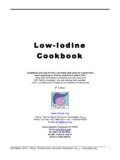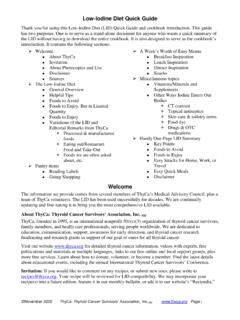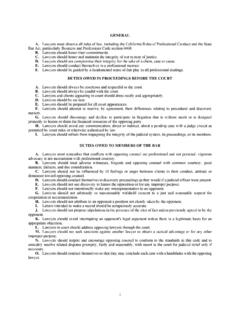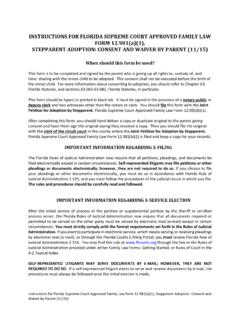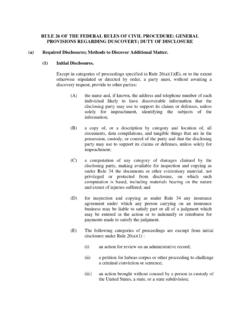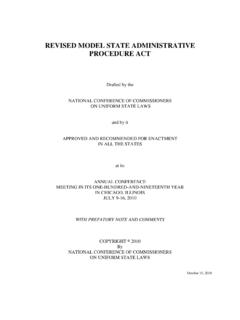Transcription of Radiation Safety in the Treatment of Patients with …
1 ARTICLER adiation Safety in the Treatment of Patientswith Thyroid Diseases by Radioiodine131I: PracticeRecommendations of the American Thyroid AssociationThe American Thyroid Association Taskforce on radioiodine SafetyJames C. Sisson,1 John Freitas,2 Iain Ross McDougall,3 Lawrence T. Dauer,4 James R. Hurley,5 James D. Brierley,6 Charlotte H. Edinboro,7,*David Rosenthal,8,{Michael J. Thomas,9,{Jason A. Wexler,10,*Ernest Asamoah,11 ,{Anca M. Avram,1,*Mira Milas,12and Carol Greenlee13 Background: Radiation Safety is an essential component in the Treatment of Patients with thyroid diseases American Thyroid Association created a task force to develop recommendations that would inform medicalprofessionals about attainment of Radiation Safety for Patients , family members, and the public. The task force wasconstituted so as to obtain advice, experience, and methods from relevant medical specialties and :Reviews of Nuclear Regulatory Commission regulationsand International Commission on Radio-logical Protection recommendationsformed the basic structure of recommendations .}}}
2 Members of the task forcecontributed both ideas and methods that are used at their respective institutions to aid groups responsible fortreatments and that instruct Patients and caregivers in the attainment of Radiation Safety . There are insufficientdata on long-term outcomes to create evidence-based :The information was used to compile delineations of Radiation Safety . Factors and situations that governimplementation of Safety practices are cited and discussed. Examples of the development of tables to ascertain thenumber of hours or days (24-hour cycles) of Radiation precaution appropriate for individual Patients treated with131I for hyperthyroidism and thyroid cancer have been provided. Reminders in the form of a checklist are pre-sented to assist in assessing Patients while taking into account individual circumstances that would bear onradiation Safety . Information is presented to supplement the treating physician s advice to Patients and caregiverson precautions to be adopted within and outside the : recommendations , complying with Nuclear Regulatory Commission regulations and consistent withguidelines promulgated by the National Council on Radiation Protection and Measurement (NCRP-155), can helpphysicians and Patients maintain Radiation Safety after Treatment with131I of Patients with thyroid diseases.
3 Bothtreating physicians and Patients must be informed if Radiation Safety , an integral part of therapy with131I, is to beattained. Based on current regulations and understanding of Radiation exposures, recommendations have beenmade to guide physicians and Patients in safe practices after Treatment with radioactive of Nuclear Medicine, Department of Radiology, University of Michigan Health System, Ann Arbor, of Radiology, St. Joseph Mercy Hospital, Ypsilanti, of Radiology (Nuclear Medicine) and Medicine (Endocrinology), Stanford University Medical Center, Palo Alto, of Medical Physics, Memorial Sloan-Kettering Cancer Center, New York, New of Endocrinology, Diabetes and Metabolism, Department of Medicine, Weill Cornell Medical College, New York, New of Radiation Oncology, Princess Margaret Hospital, University of Toronto, Toronto, Canada7 Exponent, Inc. Health Group, Menlo Park, of Endocrinology, Nassau University Medical Center, East Meadow, New Endocrine, , Raleigh, North Hospital Center, Washington, District of and Endocrinology Consultants, Indianapolis, of Endocrine Surgery, Cleveland Clinic, Cleveland, Slope Endocrinology, Grand Junction, Colorado.
4 *ATA Public Health Committee Liaison.{ATA Clinical Affairs Committee 21, Number 4, 2011 Mary Ann Liebert, : document presentsrecommendations to providehealth providers with reasoned instructions on radiationsafety for Patients , their families, caregivers, and the public afterradioiodine ( 131i ) therapy. The recommendations should helpto ensure compliance with federal regulations of the NuclearRegulatory Commission (NRC) and reduce the potential forharmful Radiation exposure to others, and also to recognize thatrequired actions may differ when attaining compliance withexisting local regulations of other jurisdictions, for example, inCanada. Although harm from Radiation exposure to personalcontacts of131I-treated Patients has not been shown, theserecommendations follow the principle of reducing radiationexposure to levels that are as low as reasonably achievable(ALARA). Inherent within ALARA is an acknowledgementthat even unapparent Radiation injuries are cumulative, andthat, over time, small effects contribute to definitive recommendations are derived from a review ofcurrent practices , expert opinions, and the literature.}
5 Theyare not meant to be evidence-based guidelines since there areinsufficient data on long-term outcomes on which to baseuse or lack of use of any Radiation exposure recommendations are based on data derived from rele-vant measurements of Radiation exposure, 131i clearance andexcretion, and reports of the impact of precautions in limitingradiation exposure. They are meant to clarify Safety precau-tions necessary and helpful in complying with NRC regula-tions and reducing doses to ALARA. They emphasize theroles of the treating physician and the Radiation Safety officer(RSO) in individualizing the precautions for each patientwhile allowing the referring physician to assist in preparingappropriate and adequate pre- and post-therapy actions. Thehierarchy of authority and responsibility for Radiation safetyis delineated in Table 1. Untoward short- and long-term ef-fects of Radiation on the treated patient, such as sialadenitis,lacrimal duct obstruction, red marrow suppression, radiationpneumonitis, and secondary neoplasms, are not , breast Radiation is discussed as an extension of re-strictions on 2008, the American Thyroid Association (ATA) assem-bled a multidisciplinary task force to formulate recommen-dations for131I Safety precautions.
6 The ATA Board ofDirectors desired that these recommendations reflect all spe-cialties involved with radioiodine treatments and Safety forthyroid Patients , their families, caregivers (a term that includesroommates and friends), and the public. They appointed rep-resentatives from the relevant disciplines, including NuclearMedicine, Radiation Safety , Medical Physics, Endocrinology,and Endocrine Surgery. Liaisons from the Clinical Affairs andPublic Health committees also assisted the process. Fundingwas derived solely from the general funds of the ATA. The finaldocument has been approved by the ATA Board of Directorsand officially endorsed by the: Academy of Molecular Imaging(AMI), American Association of Endocrine Surgeons (AAES), of Authority and Responsibility for Radiation Safety in Treatmentof Patients with radioiodine ( 131i )Nuclear Regulatory Commission (NRC)a Established by Congress Authority*Establishes policies and regulations.*Grants licenses to institutions and physicians to treat Patients with radioiodine -131.
7 Responsibility*Ensures Radiation Safety for Patients , families, caregivers, and the public.*Issues instructions regarding new policies and regulations.*Receives reports of medical events, that is, breaches in Radiation Safety . The Advisory Committee on the Medical Uses of Isotopes (ACMUI) advises NRC on policy and technical issues that arisein the regulation of the medical uses of radioactive material in diagnosis and therapy. Agreement States, agencies are established by state governments to monitor Radiation Safety and report to NRC. In otherstates, the NRC directly oversees observances of Radiation Treatment Teams (for licensure and reports: ) Radiation Safety Officer (RSO)*Develops and oversees Treatment protocols for Patients with usual Radiation Safety risks.*Provides specific advice for Patients with unusual Safety risks.*Reports medical events to State Agency or to NRC. A Radiation Health Physicist may bridge the responsibilities between RSOs and Treatment Prescription andImplementation Group.
8 Duties ofTreatment Prescription and Implementation Group (consists of physicians and clinical support staff )*With RSO, create Treatment protocols for Patients with usual Radiation Safety risks.*With RSO, plan specific treatments for Patients who may require additional Safety precautions.*Deliver oral and written advice specific to each patient.*Obtain written consent for therapy by patient or guardian.*Prescribe therapies.*Respond to medical events observed or reported.*Report to, discuss with, RSO all medical events in Radiation also regulates Radiation Safety through specific guidance programs for other organizations such as industrial radiography,commercial radiopharmaceuticals, and nuclear ET Academy of Otolaryngology-Head and Neck Surgery(AAO-HNS), American College of Nuclear Medicine (ACNM),American Head and Neck Society (AHNS), Endocrine Society(ENDO), European Society of Endocrinology (ESE),Interna-tional Radiation Protection Agency (IRPA), Latin AmericanThyroid Society (LATS), and Ukrainian Association of Endo-crine Surgeons (UAES).
9 TheAmerican College of Surgeons(ACS)and the American Congress of Obstetricians and Gy-necologists (ACOG) acknowledge support of the overall goal of these recommendations was to limitradiation exposure from Patients treated with131I to familymembers, caregivers, and the general public, consistent withALARA and NRC regulations. The task force recognized thatseveral of the precautions traditionally thought to be neces-sary offered little benefit or protection from Radiation expo-sure, whereas others that were often overlooked served toreduce exposure. They also recognized the critical need ofindividualization in providing instructions so as to ensurereductions to ALARA for those involved. Individuals differnot only in their social situations but also in the activities of131I received and rates of clearance from the body. The taskforce acknowledged that the RSO at each treating facility iscritical in Treatment planning and execution and should be thefinal arbiter of precautions for any given patient.
10 However,clinical evaluation and preparation of the patient for the131 Itreatment often precedes the encounter with the RSO. A dis-cussion of patient-specific Radiation Safety precautions shouldalso be part of the shared decision-making with the patientand the referring and/or treating physicians and should allowthe patient to select the best timing for131I Treatment and tomake appropriate preparations at home and at the United States, the NRC replaced the Atomic EnergyCommission in regulating unsealed sources of radioactivity(Energy Reorganization Act 1974). In 1997 and in 2009 up-dates (1), the NRC changed its pre-1997 release requirementsfor Patients treated with131I from an activity-based limit, the amount administered expressed in millicuries (mCi) ormegabecquerels (MBq) to a dose-based limit, the absorbeddose expressed in roentgen equivalent man (rem) or sieverts(Sv). The resultant Patient Release Criteria Rule allows re-lease of treated Patients from control of the treating facilitywith higher levels of radioactivity than previously permissi-ble.

